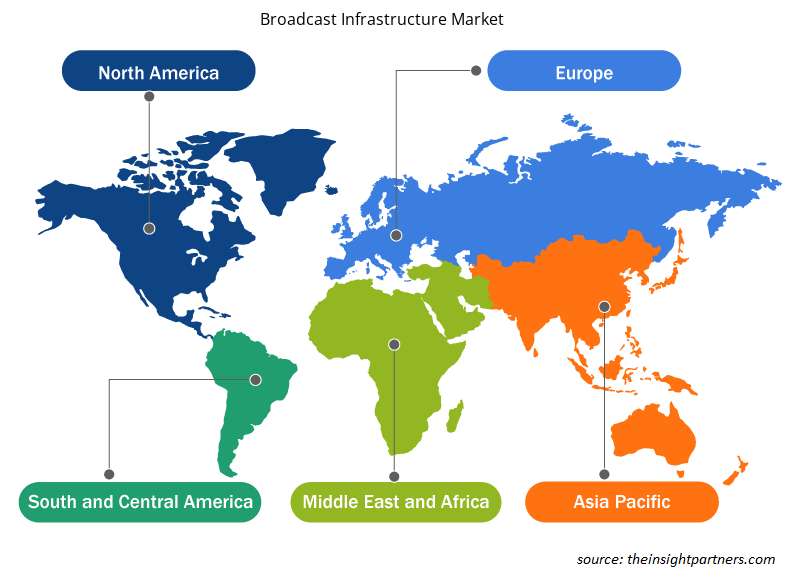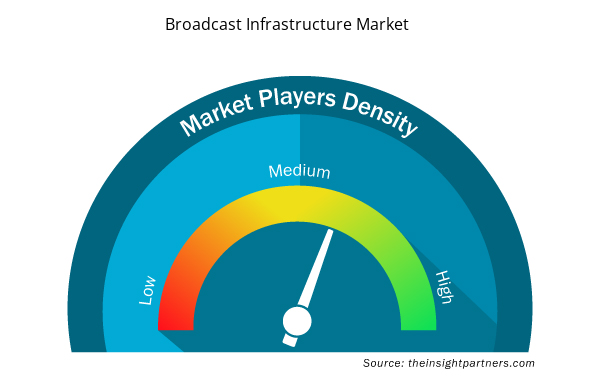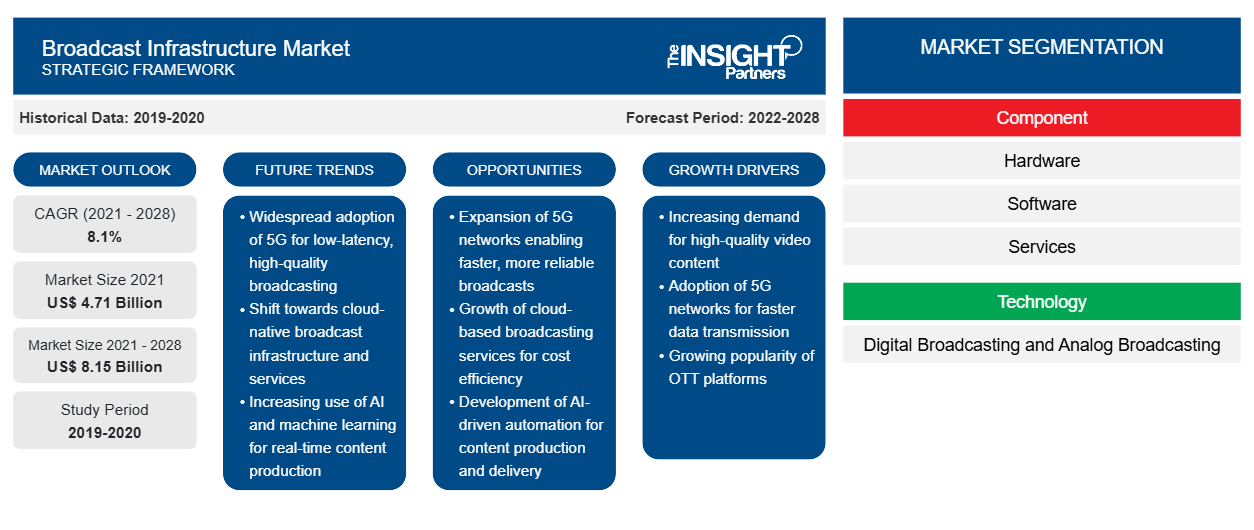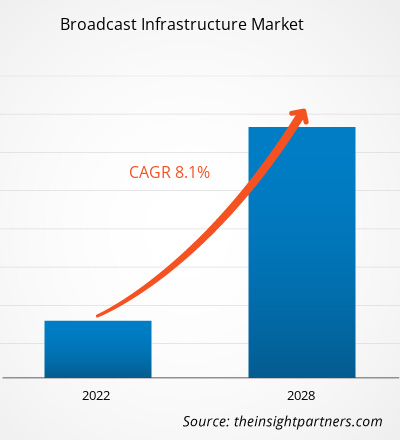[Rapport de recherche] Le marché des infrastructures de diffusion a été évalué à 4 713,7 millions USD en 2021 et devrait atteindre 8 145,7 millions USD d'ici 2028 ; il devrait croître à un TCAC de 8,1 % de 2021 à 2028.
Le changement de paradigme de l'industrie de la radiodiffusion, de la technologie analogique à la technologie numérique, a introduit une infrastructure de diffusion avancée, qui est relativement complexe. L'industrie de la radiodiffusion connaît une demande importante de nouvelles technologies de diffusion telles que la télévision sur protocole Internet ( IPTV ), la télévision sur le Web, la télévision haute définition (HDTV) et le paiement à la séance. La demande d'expériences vidéo enrichies devrait ouvrir la voie aux diffuseurs du monde entier, en particulier en Asie. Un autre facteur clé qui stimule le marché des infrastructures de diffusion est celui des plates-formes intégrées composées de serveurs, de décodeurs et de systèmes de protection du contenu vidéo, ainsi que des outils, des intergiciels et des systèmes de facturation appropriés, permettant la fourniture d'une variété de services de télévision dans plusieurs formats, tels que la vidéo à la demande, le streaming et la télévision en différé, sur la base d'une combinaison de réseaux IP sous-jacents et de systèmes d'accès DSL ou optiques. De nos jours, les fournisseurs passent d'une infrastructure matérielle à une infrastructure logicielle en raison du coût élevé de l'infrastructure matérielle de diffusion, des coûts de maintenance élevés et des mises à niveau matérielles fréquentes. L’industrie de la radiodiffusion a connu des innovations révolutionnaires avec des développements technologiques pour offrir une meilleure expérience aux utilisateurs et créer une opportunité pour les fournisseurs d’infrastructures de diffusion.
Personnalisez ce rapport en fonction de vos besoins
Vous bénéficierez d'une personnalisation gratuite de n'importe quel rapport, y compris de certaines parties de ce rapport, d'une analyse au niveau des pays, d'un pack de données Excel, ainsi que de superbes offres et réductions pour les start-ups et les universités.
- Obtenez les principales tendances clés du marché de ce rapport.Cet échantillon GRATUIT comprendra une analyse de données, allant des tendances du marché aux estimations et prévisions.
Impact de la pandémie de COVID-19 sur le marché des infrastructures de diffusion
En raison de la pandémie de COVID-19, un grand nombre de personnes travaillent à domicile et passent plus de temps en ligne, se vantant du passage au numérique. Cette demande de ressources numériques met encore plus à rude épreuve les systèmes de plusieurs entreprises de logiciels et de plateformes et entrave leur capacité à fournir des services de manière fiable et de qualité. Cependant, l'épidémie de COVID-19 a eu un impact négatif sur les acteurs impliqués dans la fourniture de contenu vidéo aux utilisateurs finaux, en raison de l'arrêt des activités et de la pénurie de main-d'œuvre. La crise de COVID-19 a également bouleversé considérablement les opérations tout au long de la chaîne de valeur, des réseaux de fournisseurs à l'expérience de livraison des clients en raison des fermetures d'entreprises , des interdictions de voyager et des perturbations de la chaîne d'approvisionnement.
Informations sur le marché – Marché des infrastructures de diffusion
Adoption croissante de nouvelles technologies de diffusion
Avec l'amélioration continue de la numérisation et l'augmentation du revenu disponible, le marché connaît un taux d'adoption élevé de l'IPTV et de la HDTV. La demande d'expériences vidéo enrichies devrait ouvrir la voie aux diffuseurs du monde entier, en particulier en Asie. La prolifération du haut débit augmente dans toute la région Asie-Pacifique, en raison du visionnage à la demande des consommateurs. De plus, les plateformes OTT (Over-The-Top) par abonnement telles que Netflix gagnent du terrain en Asie. L'augmentation des dépenses publiques consacrées aux infrastructures basées sur le cloud, aux solutions basées sur le cloud et aux services gérés, ainsi qu'aux réseaux hybrides devrait stimuler la croissance du marché des infrastructures de diffusion. Les préoccupations croissantes en matière de sécurité et le maintien de la confiance des clients encourageront les diffuseurs à adopter de nouveaux modèles de diffusion. Toutes les avancées et tous les développements sont susceptibles d'avoir un impact positif sur la croissance du marché au cours de la période de prévision.
Informations basées sur les composants
En fonction des composants, le marché des infrastructures de diffusion est segmenté en matériel, logiciel et service. Le segment des logiciels détenait la plus grande part de marché en 2020.
Aperçu régional du marché des infrastructures de diffusion
Les tendances et facteurs régionaux influençant le marché des infrastructures de diffusion tout au long de la période de prévision ont été expliqués en détail par les analystes d'Insight Partners. Cette section traite également des segments et de la géographie du marché des infrastructures de diffusion en Amérique du Nord, en Europe, en Asie-Pacifique, au Moyen-Orient et en Afrique, ainsi qu'en Amérique du Sud et en Amérique centrale.

- Obtenez les données régionales spécifiques au marché des infrastructures de diffusion
Portée du rapport sur le marché des infrastructures de diffusion
| Attribut de rapport | Détails |
|---|---|
| Taille du marché en 2021 | 4,71 milliards de dollars américains |
| Taille du marché d'ici 2028 | 8,15 milliards de dollars américains |
| Taux de croissance annuel moyen mondial (2021-2028) | 8,1% |
| Données historiques | 2019-2020 |
| Période de prévision | 2022-2028 |
| Segments couverts | Par composant
|
| Régions et pays couverts | Amérique du Nord
|
| Leaders du marché et profils d'entreprises clés |
|
Densité des acteurs du marché : comprendre son impact sur la dynamique des entreprises
Le marché des infrastructures de diffusion connaît une croissance rapide, stimulé par la demande croissante des utilisateurs finaux en raison de facteurs tels que l'évolution des préférences des consommateurs, les avancées technologiques et une meilleure connaissance des avantages du produit. À mesure que la demande augmente, les entreprises élargissent leurs offres, innovent pour répondre aux besoins des consommateurs et capitalisent sur les tendances émergentes, ce qui alimente davantage la croissance du marché.
La densité des acteurs du marché fait référence à la répartition des entreprises ou des sociétés opérant sur un marché ou un secteur particulier. Elle indique le nombre de concurrents (acteurs du marché) présents sur un marché donné par rapport à sa taille ou à sa valeur marchande totale.
Les principales entreprises opérant sur le marché des infrastructures de diffusion sont :
- Cisco Systems, Inc.
- Technologie de diffusion Clyde
- Systèmes informatiques CS Ltée.
- Dacast Inc.
- EVS Broadcast Equipment SA
Avis de non-responsabilité : les sociétés répertoriées ci-dessus ne sont pas classées dans un ordre particulier.

- Obtenez un aperçu des principaux acteurs du marché des infrastructures de diffusion
Les acteurs opérant sur le marché des infrastructures de diffusion se concentrent principalement sur le développement de produits avancés et efficaces.
- En juin 2021, EVS, le principal fournisseur de technologie vidéo en direct pour les productions de diffusion et de nouveaux médias, a annoncé son partenariat avec Gravity Media pour fournir le système d'examen multi-caméras Xeebra comme technologie de base pour la nouvelle solution intégrée de communication et d'arbitrage vidéo de la société.
- En juin 2021, Ross Video a annoncé l'acquisition de Primestream, une société de solutions de workflow pour les actifs multimédias. Ces solutions sont utilisées par des clients dans divers secteurs verticaux du marché, notamment les entreprises, les médias numériques, le sport et la diffusion. Leurs solutions sont conçues pour résoudre les défis créatifs, commerciaux et technologiques uniques et de plus en plus complexes de chaque marché. Grâce à cette acquisition, Ross cherchera naturellement à combiner sa solution de gestion des actifs multimédias Streamline avec les produits Primestream au fil du temps, pour créer une plate-forme de gestion des actifs graphiques et de production entièrement convergée.
Le marché des infrastructures de diffusion a été segmenté comme suit :
Marché des infrastructures de diffusion – par composant
- Matériel
- Logiciel
- Services
Marché des infrastructures de diffusion – par technologie
- Diffusion numérique
- Diffusion analogique
Marché des infrastructures de diffusion – par application
- OTT
- Terrestre
- Satellite
- IPTV
- Autres
Marché des infrastructures de diffusion – par géographie
- Amérique du Nord
- NOUS
- Canada
- Mexique
- Europe
- Allemagne
- France
- Italie
- ROYAUME-UNI
- Russie
- Reste de l'Europe
- Asie-Pacifique (APAC)
- Australie
- Chine
- Inde
- Japon
- Corée du Sud
- Reste de l'APAC
- Moyen-Orient et Afrique (MEA)
- Arabie Saoudite
- Émirats arabes unis
- Afrique du Sud
- Reste de la MEA
- Amérique du Sud (SAM)
- Brésil
- Argentine
- Reste de SAM
Marché des infrastructures de diffusion – Profils d’entreprises
- Cisco Systems, Inc.
- Technologie de diffusion Clyde
- Systèmes informatiques CS Ltée.
- Dacast Inc.
- EVS Broadcast Equipment SA
- Vallée de l'herbe
- Kaltura
- Névion
- Vidéo Ross Ltée
- Zixi
- Analyse historique (2 ans), année de base, prévision (7 ans) avec TCAC
- Analyse PEST et SWO
- Taille du marché Valeur / Volume - Mondial, Régional, Pays
- Industrie et paysage concurrentiel
- Ensemble de données Excel


- Health Economics and Outcome Research (HEOR) Services Market
- Mobile Phone Insurance Market
- 3D Mapping and Modelling Market
- Electronic Health Record Market
- Pharmacovigilance and Drug Safety Software Market
- Electronic Shelf Label Market
- Europe Surety Market
- Helicopters Market
- Emergency Department Information System (EDIS) Market
- Enteral Nutrition Market

Report Coverage
Revenue forecast, Company Analysis, Industry landscape, Growth factors, and Trends

Segment Covered
This text is related
to segments covered.

Regional Scope
North America, Europe, Asia Pacific, Middle East & Africa, South & Central America

Country Scope
This text is related
to country scope.
Questions fréquemment posées
US led the broadcast infrastructure market globally with a market share of 68.7% in the year 2020. For instance, For instance in 2021, DigitalBridge Group, an American made an announcement to acquire a majority stake in Vertical Bridge, the largest operator of wireless communications infrastructure in the US with an aim to meet the rising demands for broadcast infrastructure solutions. Significant investments in the 5G infrastructure by the government of the US has created a tremendous long-term growth opportunities for telecommunications infrastructure in the region.
The major companies in broadcast infrastructure includes Computer System, Grass Valley, EVS Broadcast Equipment, Nevion, Kaltura, among others. The ranking has been derived analysing multiple parameters such as annual revenue earned from broadcast infrastructure portfolio, client base, geographic locations, R&D expenditure, brand image, and number of employees, among others. These companies are actively participating in developing broadcast infrastructure for various applications.
The broadcast infrastructures have been in use for several years worldwide, however, the technology has been experiencing immense demand in recent years. The noteworthy increasing adoption of new broadcast technologies and migration from hardware to software based infrastructure is supporting the growth of broadcast infrastructure market. Moreover, the demand for cloud-based solutions in the broadcast industry for low cost and high scalability increases, the opportunities for market players who provide cost-effective and efficient streaming will propel the growth of the market.
In 2020, North America led the market with a substantial revenue share, followed by Europe, and APAC. Asia Pacific is a prospective market for broadcast infrastructure market players.
Increasing demand of Digital Terrestrial TV (DTTV) is the key opportunity for the broadcast infrastructure market. Growing demand of smart TVs, and advancements in telecom and broadcast industry is anticipated to drive the growth of Digital Terrestrial Television (DTT). With increasing consumption of TV sets and expenditure on terrestrial networks for quality, entertainment, and family friendly purpose, the demand for DTT has boosted.
The global broadcast infrastructure market was dominated by terrestrial segment with market share of 44% in 2020. Terrestrial television refers to methods of television broadcasting which do not include satellite transmission or through underground cables. The transition to digital terrestrial TV from analog terrestrial TV can be considered a significant development for the broadcasting industry. While the implementation of digital broadcasting has been led by satellite, cable, and to some extent IPTV, it is the evolution of the terrestrial broadcast platform that perhaps brings most benefits to the society.
Trends and growth analysis reports related to Electronics and Semiconductor : READ MORE..
The List of Companies - Broadcast Infrastructure Market
- Cisco Systems, Inc.
- Clyde Broadcast Technology
- CS Computer Systems Ltd.
- Dacast Inc.
- EVS Broadcast Equipment SA
- Grass Valley
- Kaltura
- Nevion
- Ross Video Ltd
- Zixi
The Insight Partners performs research in 4 major stages: Data Collection & Secondary Research, Primary Research, Data Analysis and Data Triangulation & Final Review.
- Data Collection and Secondary Research:
As a market research and consulting firm operating from a decade, we have published and advised several client across the globe. First step for any study will start with an assessment of currently available data and insights from existing reports. Further, historical and current market information is collected from Investor Presentations, Annual Reports, SEC Filings, etc., and other information related to company’s performance and market positioning are gathered from Paid Databases (Factiva, Hoovers, and Reuters) and various other publications available in public domain.
Several associations trade associates, technical forums, institutes, societies and organization are accessed to gain technical as well as market related insights through their publications such as research papers, blogs and press releases related to the studies are referred to get cues about the market. Further, white papers, journals, magazines, and other news articles published in last 3 years are scrutinized and analyzed to understand the current market trends.
- Primary Research:
The primarily interview analysis comprise of data obtained from industry participants interview and answers to survey questions gathered by in-house primary team.
For primary research, interviews are conducted with industry experts/CEOs/Marketing Managers/VPs/Subject Matter Experts from both demand and supply side to get a 360-degree view of the market. The primary team conducts several interviews based on the complexity of the markets to understand the various market trends and dynamics which makes research more credible and precise.
A typical research interview fulfils the following functions:
- Provides first-hand information on the market size, market trends, growth trends, competitive landscape, and outlook
- Validates and strengthens in-house secondary research findings
- Develops the analysis team’s expertise and market understanding
Primary research involves email interactions and telephone interviews for each market, category, segment, and sub-segment across geographies. The participants who typically take part in such a process include, but are not limited to:
- Industry participants: VPs, business development managers, market intelligence managers and national sales managers
- Outside experts: Valuation experts, research analysts and key opinion leaders specializing in the electronics and semiconductor industry.
Below is the breakup of our primary respondents by company, designation, and region:

Once we receive the confirmation from primary research sources or primary respondents, we finalize the base year market estimation and forecast the data as per the macroeconomic and microeconomic factors assessed during data collection.
- Data Analysis:
Once data is validated through both secondary as well as primary respondents, we finalize the market estimations by hypothesis formulation and factor analysis at regional and country level.
- Macro-Economic Factor Analysis:
We analyse macroeconomic indicators such the gross domestic product (GDP), increase in the demand for goods and services across industries, technological advancement, regional economic growth, governmental policies, the influence of COVID-19, PEST analysis, and other aspects. This analysis aids in setting benchmarks for various nations/regions and approximating market splits. Additionally, the general trend of the aforementioned components aid in determining the market's development possibilities.
- Country Level Data:
Various factors that are especially aligned to the country are taken into account to determine the market size for a certain area and country, including the presence of vendors, such as headquarters and offices, the country's GDP, demand patterns, and industry growth. To comprehend the market dynamics for the nation, a number of growth variables, inhibitors, application areas, and current market trends are researched. The aforementioned elements aid in determining the country's overall market's growth potential.
- Company Profile:
The “Table of Contents” is formulated by listing and analyzing more than 25 - 30 companies operating in the market ecosystem across geographies. However, we profile only 10 companies as a standard practice in our syndicate reports. These 10 companies comprise leading, emerging, and regional players. Nonetheless, our analysis is not restricted to the 10 listed companies, we also analyze other companies present in the market to develop a holistic view and understand the prevailing trends. The “Company Profiles” section in the report covers key facts, business description, products & services, financial information, SWOT analysis, and key developments. The financial information presented is extracted from the annual reports and official documents of the publicly listed companies. Upon collecting the information for the sections of respective companies, we verify them via various primary sources and then compile the data in respective company profiles. The company level information helps us in deriving the base number as well as in forecasting the market size.
- Developing Base Number:
Aggregation of sales statistics (2020-2022) and macro-economic factor, and other secondary and primary research insights are utilized to arrive at base number and related market shares for 2022. The data gaps are identified in this step and relevant market data is analyzed, collected from paid primary interviews or databases. On finalizing the base year market size, forecasts are developed on the basis of macro-economic, industry and market growth factors and company level analysis.
- Data Triangulation and Final Review:
The market findings and base year market size calculations are validated from supply as well as demand side. Demand side validations are based on macro-economic factor analysis and benchmarks for respective regions and countries. In case of supply side validations, revenues of major companies are estimated (in case not available) based on industry benchmark, approximate number of employees, product portfolio, and primary interviews revenues are gathered. Further revenue from target product/service segment is assessed to avoid overshooting of market statistics. In case of heavy deviations between supply and demand side values, all thes steps are repeated to achieve synchronization.
We follow an iterative model, wherein we share our research findings with Subject Matter Experts (SME’s) and Key Opinion Leaders (KOLs) until consensus view of the market is not formulated – this model negates any drastic deviation in the opinions of experts. Only validated and universally acceptable research findings are quoted in our reports.
We have important check points that we use to validate our research findings – which we call – data triangulation, where we validate the information, we generate from secondary sources with primary interviews and then we re-validate with our internal data bases and Subject matter experts. This comprehensive model enables us to deliver high quality, reliable data in shortest possible time.


 Obtenez un échantillon gratuit pour ce rapport
Obtenez un échantillon gratuit pour ce rapport